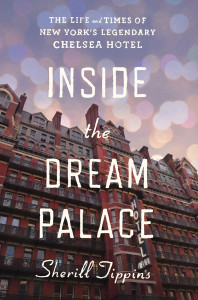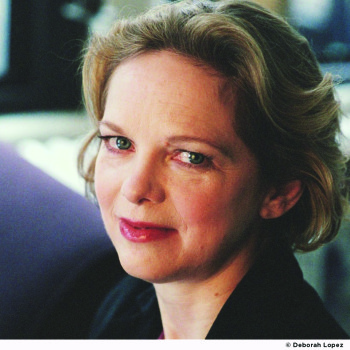Writer Sherill Tippins’ 2006 book “February House: The Story of W. H. Auden, Carson McCullers, Jane and Paul Bowles, Benjamin Britten, and Gypsy Rose Lee, Under One Roof in Brooklyn” investigated a single brownstone which became an influential “live-in salon” for early-20th-century creatives.
New York City-based Tippins traveled less than five miles to find the subject of her new follow-up, published this week. “Inside the Dream Palace: The Life and Times of New York’s Legendary Chelsea Hotel” explores the historic landmark and its famous residents, from Dylan Thomas to Dee Dee Ramone.

The Chelsea was created by Philip Hubert, a Utopian-minded Frenchmen. It was eleven stories high when almost everybody lived in five-story brownstones so it towered over the whole city. And the theory was to create a synergistic energy, a kind of human transcendence through the interaction of all different kinds of people, rich and poor, artists and working men.
He really wanted to encourage people to get to know each other, so he would create different places for people to socialize. The halls were eight feet wide so that they were like little village streets. People would linger and chat. He had communal dining rooms where everyone ate together, downstairs. His favorite place was the roof.
Part of this Utopian thought was that the higher you get in the building, the more spiritual the atmosphere was supposed to get. There was a huge circular staircase that wound up eleven stories to the roof so, by the time you reach the roof, you have literally transcended the Chelsea.
It’s such an amazing place. It’s a jumble of chimneys and peaked roofs and this century-old brick pavement and the movement of the clouds. New York was famous in the 1800’s for having beautiful “Venetian skies,” and at the top of the Chelsea you can actually see that. Beautiful, amazing sunsets behind the Hudson river. You do feel the transcendence still. And the roof is where all of this creative and artistic energy that the Chelsea is so famous for congealed.
It really hit its stride in the late 1950’s and early 1960’s. There was composer named George Kleinsinger — he turned his penthouse into a jungle. He had an eight-foot python and a tortoise and exotic birds. He was a big party guy, so people loved coming to the jungle and hanging out in the jungle. He had a big grand piano and he would play music for everybody.

Another person who lived on the top floor of the Chelsea was Arthur C. Clarke, who was working on “2001: A Space Odyssey” with Stanley Kubrick. He was also a big partier, and he was very popular. For example, he brought one of the first portable lasers up to the roof and he would aim it down at the sidewalk. Passersby would be very confused and they would chase it, or their pet dogs would chase it down the sidewalk, and everybody would laugh.
My favorite story, I think, is one time when the synergy on the rooftop failed to occur. The summer of 1967. I think it was August. Experimental filmmaker Shirley Clarke was going to have The Grateful Dead give a concert.
They started a few songs and everything was great, it was a beautiful summer night. But all of a sudden, Andy Warhol wandered up with his entourage. He was standing there watching from behind his sunglasses — at night — watching this lovely Californian music. The song falters, it slows down, and finally the musicians just put their instruments down. They say “Sorry, this isn’t working, we can’t play in this atmosphere.” And they blame Andy Warhol; they say he was sucking all the energy out of the experience. He was like “an ambulatory black hole,” is what they called him!
The Chelsea Hotel has now been sold, and it is unknown what is going to happen to the roof. We’ll know in about a year I guess.


